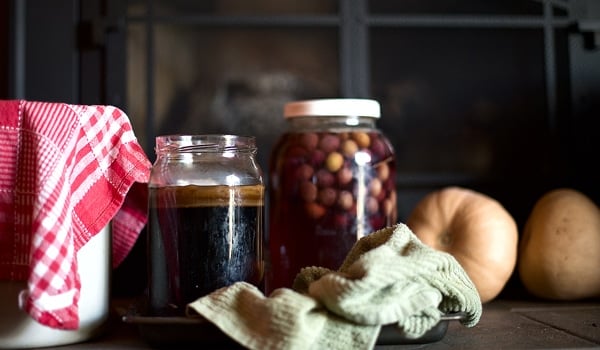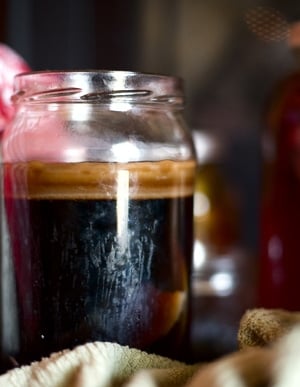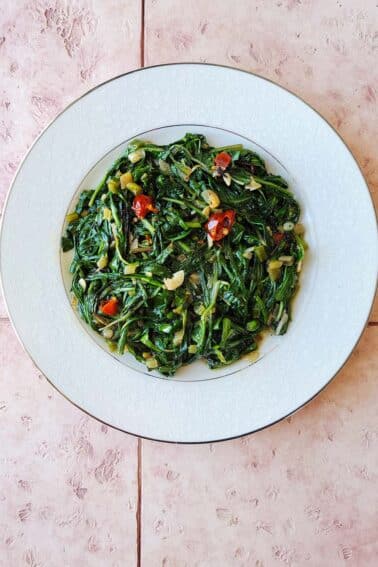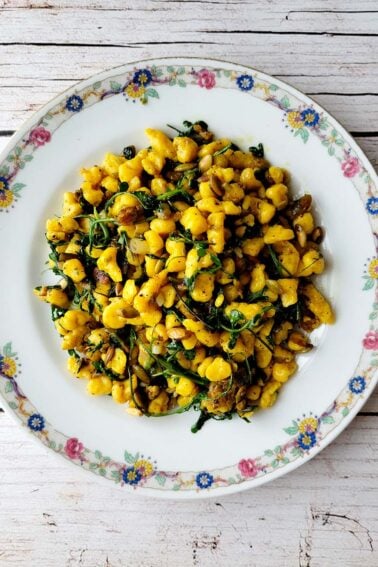As an Amazon Associate I earn from qualifying purchases.

Beer vinegar.
Let those words hang in the air for a moment. Such a simple thing, so obvious… but chances are you’ve never seen it. Beer vinegar is a close cousin to malt vinegar, which you probably have encountered, at least with your fish and chips. The biggest difference is your base product.
Malt vinegar is made from malted barley allowed to kinda-sorta become an ale. Beer vinegar is made from finished beers of all types, and the character of those beers carries through in the finished vinegar. (It is the key to my recipe for Duck Breast with Beer Sauce.)

It’s freakin’ amazing. First of all, you have so many different beers to choose from. Vinegar made from Budweiser will be different from vinegar made from Guinness, or from an India pale ale or a porter or a lambic or a Belgian tripel… you get my point.
Red wine vinegar is pretty much red wine vinegar. Yes, there are good examples and bad ones, but there’s a certain sameness to them all.
The diversity of beer vinegar is more like that between red wine and white wine vinegar. Come to think of it, beer is even more diverse than wine.
And what’s more: Beer is the perfect medium to make vinegar.
If you’ve ever made wine vinegar, you might notice that some wines are simply too strong for the acetic acid bacteria to handle. I’ve been making red wine vinegar for several years and I always find that I need to dilute it with water to lower the alcohol content, otherwise the “mother” won’t take. Beer, however, is typically 3.2 percent to 12 percent alcohol, with most good ones around 6 percent or so. Perfect.
How do you make beer vinegar?
Easy. Get yourself a big, wide-mouthed jar, or better yet, a stoneware 1 gallon pickling crock, or hell, get a two-gallon crock if you plan on making lots of vinegar. Pour some beer in there and add a vinegar mother. The mother I just linked to is a nice, neutral one, but honestly it doesn’t matter if the mother came from red wine or white wine. They’ll all work. Only thing is that a red wine vinegar mother will be, well, red, and so you might not want to drop it into a nice, light-colored pilsner vinegar. I used my red wine mother for this dark beer vinegar and it came out fine. And notice that it changed color to match that of the dark beer?
What beer did I use here? Black lager. I’ve also made it with porter and with a pilsner. All very different, all very good.
Once you drop the mother into the crock, cover it with a towel and set it in a dark place at room temperature or warmer. I’ve done some at 100°F and they loved it. Vinegar needs air, remember, so don’t seal the crock or jar. And yes, it will smell like vinegar, so maybe the hearth isn’t the best place for yours. Holly is used to my “Hanksperiments,” and is pretty tolerant…
Don’t have a vinegar mother? Well, if you are sporty, you can let nature do it. Or, rather nature’s little vinegar helpers, the fruit fly. Yep. Keep the beer outside and let the fruit flies land on it. Once you see a couple dead ones on the beer, now you can cover the crock and continue on your way.
Fruit flies have acetobacter bacteria all over their feet, and will transfer that bacteria to your beer. Don’t worry: Once the vinegar is ready, it will be so acidic it will be safe to use. You might want to strain out the dead fruit flies, though…

Now, wait. It takes a month or two for the vinegar to really be ready, depending on how large a batch you are making. Taste after a month. Also, watch for the mother to sink. That’s a good indicator you need to either finish this batch and start a new one, or add to this batch — it means the mother needs more alcohol to eat.
Strain the vinegar through cheesecloth or a paper towel into a Mason jar and you are good to go. I prefer living vinegars, so I don’t heat mine, but if you want to stabilize your vinegar, you need to gently heat it to 140°F, which is steaming, not simmering, and hold it there for 10 minutes. If you plan on giving vinegar as a gift, you should do this, otherwise you’ll soon have little baby mothers in the jars.
Another option? Strain the vinegar and put it in an oak barrel. Yeah, I don’t have a barrel lying around either. There’s a cheaper way: Put the finished vinegar in a big jar and drop a bunch of oak cubes into it. Bam! Instant oak barrel. You want about a handful of cubes per quart of vinegar or so. Taste it after a couple months to see if it’s mellow and oaky enough for you. Your taste is your guide.
There you have it: The easiest vinegar you can possibly make, and one of the coolest.




Beer Vinegar….Do you leave the fruit flies in the batch for the month or do you remove them right after seeing the little critters floating…..Thanks
Mike: I skim them off after an hour or so.
Thank You for your answer ? For your Beer Vinegar recipe can I use an unopened outdated
bottled beer
that I’d been keeping for sentimental reasons?
I’d love to consume it in this fashion ?
Harmony: That should work.
I make my own beer. It rarely goes wrong, because I’m pretty scrupulous with my cleanliness.
However, once in a while it does and I was looking for what I should do with it when I came here.
My main question is how to concentrate it to use for things like pickling, as I generally make lower alcohol beers, around 3% (so I can drink more…!!!) and therefore the vinegar is also rather weak. Acetic acid boiling point is 118C, so I presume I can just carefully boil off some of the water?
I made a batch of beer Vinegar from Yuengling Lager and a little Black and Tan. the ph is 2.06. seems a little acidic for consumption. Do I need to dilute it? if so what’s the best method?
Thanks
Do I need to let fruit flys land in my beer to make a mother? Or can I just leave it in the cupboard above my stove?
Marcel: The fruit flies do help, but you can buy a vinegar mother, too. Doesn’t have to be one from beer, either. Or, you can buy live vinegar, Bragg’s in the US, and add it to the beer. That will get it started.
If I add Braggs, what is the ratio of vinegar to beer?
Hi Hank:
I make a lot of cider and pineapple vinegar and always have mother to spare. Would this mother work for beer vinegar? Thanks.
Ivan: Probably, but I’ve never done it.
Yes it will, i put about 1 cup of live ACV into an old plastic malt vinegar bottle, and then it was forgotten about in the back of a cupboard. When i found it 12 months later there was 5 or 6 thin pellicles formed in there so i split it all into 2 jars and split a can of draught Guinness between them. 2 weeks later i fed the jars another can of draught Guinness. 3 weeks later i have 1 cm thick scoby mats formed on the tops and the aroma from the jars is awesome!
If you use an aquarium pump and air stone and you can have vinegar ready in about 14-21 days, depending on the acidity. I’m making Braggot Vinegar from some leftover homebrew I didn’t have enough bottles for. A similar homebrew Perry Vinegar and Apricot Wine Vinegar with Oak Chips both turned out great using the pump and stone method.
I love all your stuff! Was just googleing for Beer Vinegar ideas and was like “oh, of course Hank would have some!”
Kent: Cool idea! Thanks.
In Denmark, where I was for awhile, some ordinary pickles I was served were scrumptious, and the recipe called for Lager Vinegar. So I bought some plain, brand-x, lager vinegar at a generic, low-price store. Ohmigosh!!! Even the commercial, plain VINEGAR there tastes outstanding (along with all the rest of the food there)……Can’t we just sell phenomenal vinegar here on a regular basis? It obviously isn’t that hard to make commercially………Next step, I’ll try your method and make some, since I can’t buy Lager Vinegar in my major, midwestern American city.
Hi!
If I put 1 liter of beer how much of mother should I put in?
Thanks a lot
Jean: I’d put in a standard floating disk that formed on top of a Mason jar, so a disc about 4 inches long by about 1/2 inch thick. That said, a mother will eventually convert all the alcohol to acetic acid, so even a little will work.
Hi again!
If I don’t put a disk and just à cheesecloth is it not gonna work? What time of floating disk should I buy?